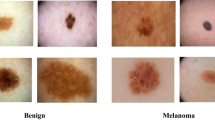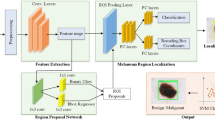Abstract
Automatic melanoma diagnosis is very important to lower the mortality rate by detecting the disease in earlier stages and accurate diagnosis. The main aim of this paper is to improve the classification accuracy of melanoma using a proposed novel color and texture feature descriptor. Initially, the skin lesion area of input dermoscopy image is segmented using a convolutional neural network-based U-Net algorithm. Then extract discriminate color, texture and combined color-texture features with the help of proposed Inter Neighbor Statistical Color Feature (INSCF), Inter Neighbor Mean Order Pattern (INMOP) and Inter Neighbor Statistical Color Mean Order Pattern (INSCMOP) by incorporating inter color channel values. This proposed feature descriptors are capable to discriminate the detailed information derived from spatial inter-chromatic texture patterns of different channels within a region. Finally, three classifiers namely, K-Nearest Neighbors (KNN), Random Forest (RF), and Support Vector Machine (SVM) are used to classify the skin lesion in a dermoscopic image as benign lesion or melanoma. Experimental results indicate that the proposed INSCMOP with Random Forest classifier achieves the highest classification performance based on accuracy of 93.27% for ISIC 2016 dataset, 86% for ISIC 2017 dataset and 92.31% for ISBI 2019 dataset. Moreover, comparing the proposed method with other systems shows that this approach has an excellent performance in melanoma classification. In this research, without any manual interaction, the classification process is performed in an automated way. It would set up a valuable assistance for dermatologist in clinical practice.














Similar content being viewed by others
References
Al-Mansi Mohammed A, Al-Antari Mugahed A, Choi MT, Han SM, Kim TS (2018) Skin lesion segmentation in dermoscopy images via deep full resolution convolutional networks. Comput Methods Prog Biomed 162:221–231
Almansour E, Jaffar AM (2016) Classification of Dermoscopic skin cancer images using color and hybrid texture features. IJCNNS Int J Comput Sci Netw Secur 16(4):135–139
Al-Masni Mohammed A, Kim D-H, Kim T-S (2020) Multiple skin lesions diagnostics via integrated deep convolutional networks for segmentation and classification. Comput Methods Prog Biomed 190:105351. https://doi.org/10.1016/j.cmpb.2020.105351
Ani Brown Mary N, Dejey D (2017) Classification of coral reef submarine images and videos using a novel Z with tilted Z local binary pattern Z+TZLBP. Wireless Pers Commun 98(3)
Arasi AM, El-Horbaty ME, Salem MA, El-Dahshan AE (2017) Stack auto encoders approach for malignant melanoma diagnosis in Dermoscopy images. ICICIS pp:403–409
Argenziano G, Soyer HP (2001) Dermoscopy of pigmented skin lesions-a valuable tool for early diagnosis of melanoma. Lancet Oncol 2(7):443–449
Argenziano G, Cerroni L, Zalaudek I, Staibano S, Hofmann-Wellenhof R, Arpaia N, Bakos RM, Balme B, Bandic J, Bandelloni R, Brunasso AMG, Cabo H, Calcara DA, Carlos-Ortega B, Carvalho AC, Casas G, Dong H, Ferrara G, Filotico R, Gómez G, Halpern A, Ilardi G, Ishiko A, Kandiloglu G, Kawasaki H, Kobayashi K, Koga H, Kovalyshyn I, Langford D, Liu X, Marghoob AA, Mascolo M, Massone C, Mazzoni L, Menzies S, Minagawa A, Nugnes L, Ozdemir F, Pellacani G, Seidenari S, Siamas K, Stanganelli I, Stoecker WV, Tanaka M, Thomas L, Tschandl P, Kittler H (2012) Accuracy in melanoma detection: a 10 year multicenter survey. J Am Acad Dermatol 67(1):54–59
Baghersalimi S, Bozorgtbar B, Schmid-Saugeon P, Kemal Ekenel H, Thiran JP (2019) DermoNet: densely linked convolutional neural network for efficient skin lesion segmentation. J Image Video Proc 71:1–10
Boser BE, Guyon IM, Vapnik VN (1992) A training algorithm for optimal margin classifiers. In: Haussler D (ed) COLT ‘92: proceedings of the fifth annual workshop on computational learning theory. ACM, New York, pp 144–152
Chitra Devi M (2020) Skin Cancer classification using Dermoscopic images based on Ranklet transform, co-occurrence features and random Forest classifier. Medico Legal Update 20(3)
Codella N, Cai J, Abedini M, Garnavi R, Halpern A, Smith JR (2015) Deep learning, sparce coding, and SVM for melanoma recognition in dermoscopy images. Machine learning in medical imaging. MLMI 2015. Lecture Notes in Computer Science, Springer, Cham 9352:118–126
Codella N, Gutman D, Celebi ME, Helba B, Marchetti MA, Dusza S, Kalloo A, Liopyris K, Mishra N, Kittler H, Halpern A (2017) Skin lesion analysis toward melanoma detection: a challenge at the 2017 international symposium on biomedical imaging (ISBI), hosted by the international skin imaging collaboration (ISIC). arXiv: 1710.05006 [cs.CV] Available: https://arxiv.org/abs/1710.05006
Garcia-Arroyo JL, Garcia-Zairain B (2019) Segmentation of skin lesions based on fuzzy classification of pixels and histogram thresholding. 168:11-19. arXiv1703.03888v1.
Goyal M, Hoon MY (2017) Multi-class segmentation of skin lesions via fully convolutional networks. IEEE JBHI special issue on skin lesion image analysis for melanoma detection. arXiv preprint arXiv:1711.10449, 1–8.
Gutman AD, Codella N, Tschandl P, Clebi ME, et al (2016) Skin Leson analysis toward melanoma detection: a challenge at the Internationl symposium on biomedical imaging (ISBI) 2016. Hosted by the international skin imaging collaboration (ISIC) 2016; arXiv:1605.01397v1.
Haralick RM, Shanmugam K, Dinstein I (1973) Textural features for image classification. IEEE Trans Syst Man Cybern 6:610–621
Harangi B (2018) Skin lesion classification with ensembles of deep convolutional neural networks. J Biomed Inform 86:25–32
Heikkila M, Pietikainen M, Schmid C (2009) Description of interest regions with local binary patterns. Pattern Recogn 42(3):425–436
Jayapriya K, Jacob IJ (2019) Hybrid fully convolutional networks-based skin lesion segmentation and melanoma detection using deep feature. Int J imaging Syst Technol 1–10
Khan MA, Akram T, Sharif M, Shahzad A, Aurangzeb K, Alhussein M, Haider SI, Altamrah A (2018) An implementation of normal distribution based segmentation and entropy controlled features selection for skin lesion detection and classification. BMC Cancer 5;18(1):638.
Khan MA, Javed MY, Sharif M, Saba T, Rehman A (2019) Multi-model deep neural network based features extraction and optimal selection approach for skin lesion classification. International Conference on Computer and Information Sciences (ICCIS) 2019:1–7. https://doi.org/10.1109/ICCISci.2019.8716400
Kittler H, Pehamberger H, Wolff K, Binder M (2002) Diagnostic accuracy of dermoscopy. Lancet Oncol 3(3):159–165
Kruk M, Swiderski B, Osowski O, Kurek J, Showriska M, Walecka I (2015) Melanoma recognition using extended set of descriptors and classifiers. EURASIP J Image Video Process 43:1–10
Li Y, Shen L (2018) Skin lesion analysis towards melanoma detection using deep learning network. Sensors (Basel) 18(2):556. https://doi.org/10.3390/s18020556
Long J, Shelhamer E, Darrell T (2015) Fully convolutional networks for semantic segmentation. In: Proceedings of the IEEE conference on computer vision and pattern recognition (CVPR). MA, Boston, pp 3431–3440
Narayanan DL, Saladi RN, Fox JL (2010) Ultraviolet radiation and skin cancer. Int J Dermatol 49(9):978–986
Nasir M, Attique Khan M, Sharif M, Lali IU, Saba T (2018) Iqbal T (2018) an improved strategy for skin lesion detection and classification using uniform segmentation and feature selection based approach. Microsc Res Tech 00:1–16
Pomponiu V, Nejati H, Cheung NM (2016) Deepmole: deep neural networks for skin lesion classification. IEEE international conference on image processing (ICIP), 2623-26.
Priyadharshini D, Rengini D (2015) Automatic melanoma detection using local binary pattern and support vector machine. Int J Innov Res Comput Commun Eng (IJIRCST) 3(9):8692–8698
Rohini S, Soma S (2017) A novel texture based skin melanoma detection using color GLCM and CS-LBP feature. Int J Comput Appl 171(5):1–5
Romero Lopez A, Giro-i-Nieto X, Burdick J, Marques O (2017) Skin lesion classification from dermoscopic images using deep learning techniques. 2017 13th IASTED international conference on biomedical engineering (BioMed), Innsbruck, Austria.49-54.
Ronneberger O, Fischer P, Brox T (2015) U-net: convolutional networks for biomedical image segmentation. International Conference on Medical Image Computing and Computer-Assisted Intervention 9351:234–241
Seeja RD, Suresh A (2019) Deep learning based skin lesion segmentation and classification of melanoma using support vector machine (SVM). Asian Pac J Cancer Prev 20(5):1555–1561
Skin Cancers (n.d.) Available online: http://www.who.int/uv/faq/skincancer/en/index1.html. Accessed 26 September 2020.
Sultana NN, Mandal B, Puhan NB (2018) Deep residual network with regularized fisher framework for detection of melanoma. IET Comput Vis 12(8):1096–1104
Wang Y, Pan H, Yang B, Bian X, Cui Q (2019) Mutual learning model for skin lesion classification. In international conference of pioneering computer scientists, engineers and educators (pp. 214-222). Springer, Singapore
Yu Z, Ni D, Chen S, Qin J et al. (2017) Hybrid dermoscopy image classification framework based on deep convolutional neural network and fisher vector. Proc IEEE 14th Int Symp Biomed Imaging.301-4
Yu L, Chen H, Dou Q, Qin J, Heng PA (2017) Automated melanoma recognition in Dermoscopy images via very deep residual networks. IEEE Trans Med Imaging 36(4):994–1004
Zhu W, Zeng N, Wang N (2010) Sensitivity, specificity accuracy associated confidence interval and ROC analysis with practical SAS implementations. NESUNG ProceedingsL health care and life sciences. 1-9.
Funding
There is no funding help from any agency.
Author information
Authors and Affiliations
Corresponding author
Ethics declarations
The manuscript entitled “Melanoma Classification Employing Inter Neighbor Statistical Color and Mean Order Pattern Texture Feature” has not been published elsewhere and that it has not been submitted simultaneously for publication elsewhere.
Conflict of interest
We, R.D Seeja and Dr. A Suresh have no conflicts of interest.
Additional information
Publisher’s note
Springer Nature remains neutral with regard to jurisdictional claims in published maps and institutional affiliations.
Rights and permissions
About this article
Cite this article
Seeja, R.D., Suresh, A. Melanoma classification employing inter neighbor statistical color and mean order pattern texture feature. Multimed Tools Appl 80, 20045–20064 (2021). https://doi.org/10.1007/s11042-021-10685-7
Received:
Revised:
Accepted:
Published:
Issue Date:
DOI: https://doi.org/10.1007/s11042-021-10685-7




